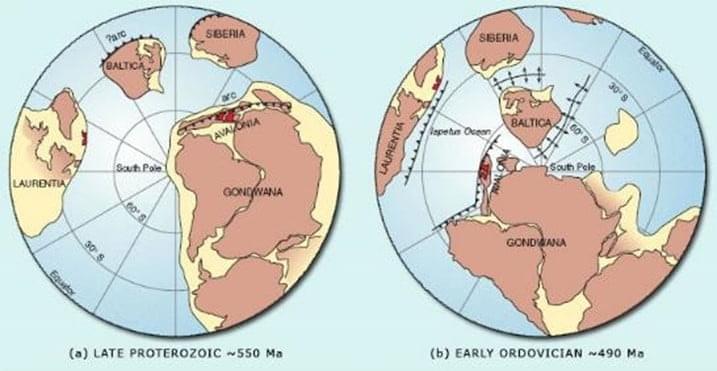700 Million Years Ago
The Birth of an Ocean – Neoproterozoic Era
Our geological story starts 700 million years ago in the Neoproterozoic Era, the final part of the Precambrian. At this time, there was one supercontinent in the southern hemisphere that we now call Rhodinia. The only parts of Ireland that were part of this continent were the island of Inishtrahull off of Co Donegal, part of the Mullet Peninsula in Co Mayo and the area south of Bray, including the Sugarloaf, in Co Wicklow.


The supercontinent Rhodinia started to rift apart (i.e. fissures slowly opened up and divided the continent) and a new ocean called the Iapetus started to open around 590 million years ago. As the two continental blocks continued to move apart, magma erupted to form a new ocean floor and sediments such as mud, sand, and gravel were deposited and limestone formed.
We see rocks of this age in Ireland in both the southeast in Co Wicklow and Co Wexford and in the northwest in Connemara, North Co Mayo, Co Sligo, Co Tyrone, Co Donegal and Co Antrim. The rocks to the southeast are associated with a vast continent we call Gondwana and the rocks to the northwest are associated with a continent we call Laurentia.
Laurentia includes parts of Scotland, Greenland, and Eastern Canada whereas Gondwana includes parts of southern Britain and the eastern edge of North America and the whole of Africa, South America and Antartica.
In the Joyce Country and Western Lakes geopark region, we see evidence of rocks of this age from Corr na Móna westwards and from Cur Hill in the Maam valley to south of Maam Cross. Our internationally famous rock, Connemara Marble, started off as limestone at the centre of the new ocean floor. The soft Lakes Marble Formation of the Maam valley was once limestone and sand found in the shallow waters of the young Iapetus Ocean, and the tops of the Maamturks and the Twelve Bens were once sand from the continent deposited on this ocean floor.